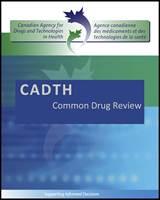Except where otherwise noted, this work is distributed under the terms of a Creative Commons Attribution-NonCommercial-NoDerivatives 4.0 International licence (CC BY-NC-ND), a copy of which is available at http://creativecommons.org/licenses/by-nc-nd/4.0/
NCBI Bookshelf. A service of the National Library of Medicine, National Institutes of Health.
Edoxaban (Lixiana) [Internet]. Ottawa (ON): Canadian Agency for Drugs and Technologies in Health; 2017 Apr.
Background
Edoxaban (Lixiana) is indicated for the treatment of patients with nonvalvular atrial fibrillation requiring chronic anticoagulation. The recommended dosage is 60 mg once daily, with the potential for dosage reduction to 30 mg once daily if required. The cost per day of treatment with edoxaban is $2.84 for all dosages.
The manufacturer submitted a cost-utility analysis conducted using a Markov model with 18 health states: stable atrial fibrillation, mild ischemic stroke (IS), moderate IS, severe IS, post–mild IS, post–moderate IS, post–severe IS, mild hemorrhagic stroke (HS), moderate HS, severe HS, post–mild HS, post–moderate HS, post–severe HS, systemic embolic event (SEE), post-SEE, acute myocardial infarction (MI), post-MI, and death. Four additional events were incorporated as transient events: other intracranial hemorrhage (ICH), transient ischemic attack (TIA), non-ICH major bleed, and clinically relevant non-major bleed. The model adopts a lifetime horizon with a cycle length of one month.
Edoxaban is compared primarily to warfarin (5 mg once daily) and rivaroxaban (60 mg once daily) in the submitted analysis. For the comparison with warfarin, data from the ENGAGE AF-TIMI 48 trial are used to model the risks for the four health states (IS, HS, SEE, and MI) and the four events (other ICH, TIA, non-ICH major bleed, and clinically relevant non-major bleed). For the comparison with rivaroxaban, data from a manufacturer-submitted network meta-analysis were used.1 Analyses comparing edoxaban with dabigatran (110 mg twice daily and 150 mg twice daily) and apixaban (5 mg twice daily) were included as sensitivity analyses, with the necessary clinical data obtained from the manufacturer-submitted network meta-analysis. The rationale for excluding these comparators from the primary analysis was twofold: (1) limited comparability of the ENGAGE AF-TIMI 48 trial of edoxaban with the pivotal trials for dabigatran and apixaban, and (2) rivaroxaban is the most commonly used new oral anticoagulant (NOAC) in Canada.
Costs are sourced from appropriate published articles or relevant databases containing Ontario data.2–7 Utility data for the baseline health state and further health states and events were obtained from the ENGAGE AF-TIMI 48 trial and the published literature.8–12 The choice of values appears appropriate and consistent with previous studies.
Summary of Identified Limitations and Key Results
According to the manufacturer’s base-case analysis, treatment with edoxaban was more effective (quality-adjusted life-year gain of 0.1517) and more costly ($1,922) than warfarin, leading to an incremental cost per quality-adjusted life-year gained of $12,672. Edoxaban was dominant compared with rivaroxaban (i.e., it was less costly and more effective). The results were consistent across all deterministic sensitivity analyses.
No major limitations with respect to the model, assumptions, and data inputs were found. The limitations relate to the context of the decision problem:
- Given the patient population from the ENGAGE AF-TIMI 48 trial, analysis is relevant only to atrial fibrillation patients with a CHADS2 (congestive heart failure, hypertension, age ≥ 75 years, diabetes mellitus, and prior stroke or TIA or thromboembolism) score ≥ 2; edoxaban may be used in patients with CHADS2 = 1.
- The submitted report only highlights the comparisons of edoxaban with warfarin and rivaroxaban. Given the current funding of NOACs, comparisons with apixaban and dabigatran are as relevant and should have been given equal prominence.
- Current effective prices for rivaroxaban, apixaban, and dabigatran are unknown, which may limit the ability to accurately interpret the results of this submission.
Conclusions
The CADTH Common Drug Review (CDR) reanalysis, which incorporated all relevant comparators (warfarin and other NOACs), found edoxaban not to be cost-effective for patients with nonvalvular atrial fibrillation (CHADS2 ≥ 2) requiring anticoagulation; apixaban was the most cost-effective NOAC, and all other NOACs (including edoxaban) were dominated (i.e., they were less effective and more costly). Apixaban remained cost-effective compared with edoxaban unless the price of the latter was reduced by 33% or more. It was noted that the relative cost-effectiveness of edoxaban versus apixaban and dabigatran is somewhat uncertain because of the limitations of the clinical data. CDR considered that there was no justification for a price premium for edoxaban should drug plan costs for apixaban, dabigatran, or rivaroxaban be lower than their list prices.
- EXECUTIVE SUMMARY - Edoxaban (Lixiana)EXECUTIVE SUMMARY - Edoxaban (Lixiana)
- DETAILED OUTCOME DATA - Edoxaban (Lixiana)DETAILED OUTCOME DATA - Edoxaban (Lixiana)
- OBJECTIVES AND METHODS - Omalizumab (Xolair)OBJECTIVES AND METHODS - Omalizumab (Xolair)
- RESULTS - Ingenol Mebutate (Picato)RESULTS - Ingenol Mebutate (Picato)
- CONCLUSIONS - Ingenol Mebutate (Picato)CONCLUSIONS - Ingenol Mebutate (Picato)
Your browsing activity is empty.
Activity recording is turned off.
See more...
